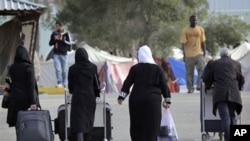The UN High Commissioner for Refugees and International Organization for Migration (UNHCR) warn escalating fighting in Libya could prompt a mass exodus from the country. They say they are preparing for a so-called worst-case scenario to assist hundreds of thousands of people who might flee across borders into neighboring countries.
Since the Libyan revolution erupted in February, more than 50,000 migrants stranded at border camps in Tunisia and Egypt have been transported home by the IOM and UNHCR. Tens of thousands of others have been taken home by airplanes and ships provided by their governments.
UNHCR’s Coordinator of Operations for the Libya Emergency, Andrew Harper, says this is the biggest civilian airlift jointly undertaken by the two organizations since the first Gulf War in 1991.
While this is a huge success, he says the crisis in Libya continues and aid agencies have to be able to respond to the unknown.
“No one knows what is going to take place in Libya. Events are changing on the ground more rapidly than we can appreciate. The imposition of the no-fly zone has a number of implications, which could impact on both the western and eastern borders and, if there is one strategy that we have, that is to be extremely flexible and be prepared for the worst-case scenario,” Harper said.
And the worst-case scenario is that the migratory flow happening now could very quickly turn into a huge refugee flow as well.
Currently, IOM and UNHCR estimate that averages of 1,500 to 2,500 people in need of evacuation are crossing into Egypt, Tunisia, Algeria and Niger every day.
IOM’s Head of Emergency and Post-Crisis Division, Fernando Calado, says this number could go up dramatically as many migrants from third world countries are still in Libya.
“And, they are probably assessing as everybody is right now what the options are now before making a decision of leaving or not. Before the crisis started, there were between 2 million and 2.5 million migrant workers. So, if you take that into consideration, the potential case load is important,” Calado said.
The UNHCR, IOM and other agencies are making contingency plans to deal with a possible spike in the number of migrants and refugees fleeing Libya. Earlier this month, the United Nations launched an inter-agency appeal for more than $160 million to help an anticipated 400,000 people fleeing to the Egyptian and Tunisian sides of the border.
To date, the UNHCR reports more than 300,000 people have fled Libya to neighboring countries.
UNHCR: Preparing For Worst Case Scenario in Libya














